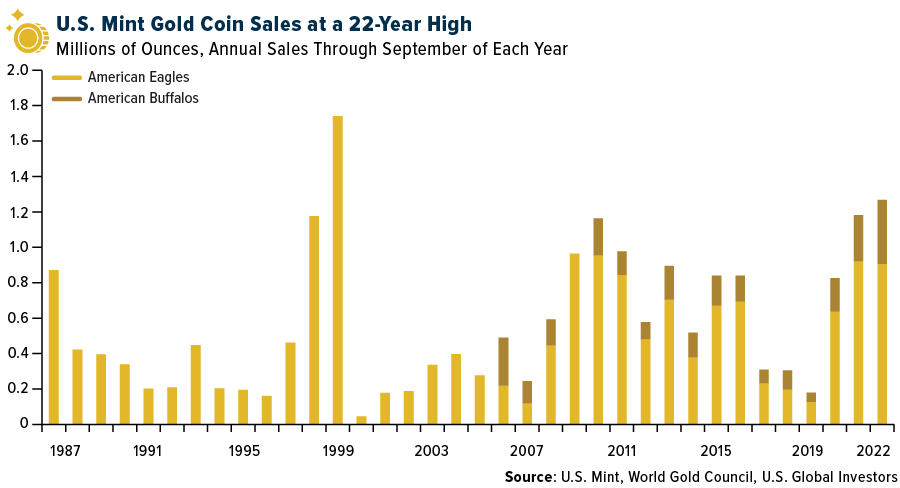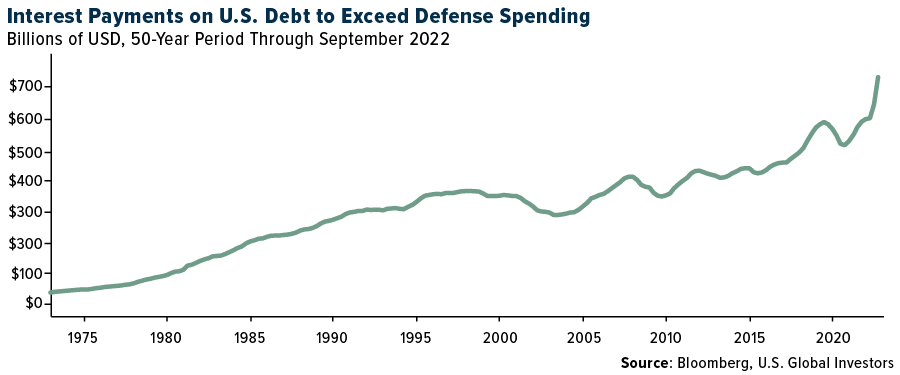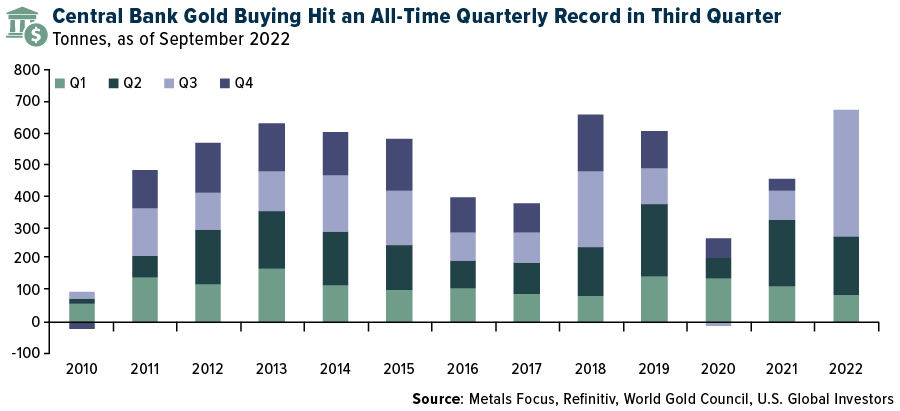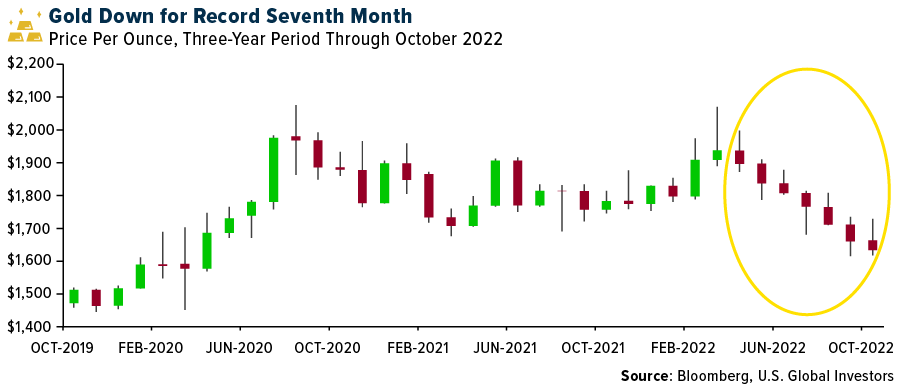As we see it, decentralized assets such as gold and silver have never looked more attractive than they do now.
By “decentralized,” we mean that these assets are not issued by a central authority. They are no one’s liability. No central banker or finance minister makes the decision to mint more gold or silver.
Investors have been diversifying with gold and silver for decades to limit their exposure to poorly executed monetary and fiscal policies. Between January and September of this year, investors bought more American Eagle and American Buffalo gold coins than in any other such period going back to 1999.
We believe this is largely a reflection of Americans’ souring opinion of the state of the economy and the imbalance they see in monetary and fiscal policies.

U.S. Spends More on Interest Than on Its Military
Take a look at where monetary and fiscal mismanagement has gotten us. Total U.S. debt now stands at an unfathomable $31 trillion, or around a quarter of a million dollars per U.S. taxpayer. Debt accounts for over 121% of the entire U.S. economy. That means that for every dollar the U.S. has, it owes a buck and a quarter (almost).
Meanwhile, the Federal Reserve has been lifting interest rates at a pace we haven’t seen in 40 years, which makes servicing debt much more expensive. The amount of money the U.S. government pays on interest alone now exceeds its defense spending.
In the third quarter of 2022, the government paid over $736 billion just on interest. That’s more than its 2020 national defense budget of $714 billion.

Central Banks Load Up on Gold
With gold and silver, there’s no need for investors to put their trust in a third party or intermediary, especially one that may not have their best interests in mind.
What we find interesting is that central banks themselves—the ultimate central authorities—recognize the power in diversifying with decentralized assets. According to the World Gold Council (WGC), global central banks collectively added a record amount of gold during the third quarter. Purchases jumped to nearly 400 metric tonnes, more than double the amount compared to the previous quarter and a new quarterly record. With these purchases, the year-to-date total for 2022 now stands at 673 tonnes, higher than any other year since 1967, the WGC says.

Gold Down for Record Seventh Month—a Buying Opportunity?
Gold’s critics will point out that the price of the precious metal has been down for seven straight months, a new all-time record, as of October.
They are correct. Due to rising interest rates and an historically strong U.S. dollar, gold has experienced a monthly losing streak unmatched since—are you ready for this?—1869.

This sounds awful, but let’s put it in context. Through the end of October, gold has fallen 11% in 2022. The S&P 500, by comparison, has lost 18%.
What about other asset classes? Well, tech stocks (Nasdaq 100) have lost even more at around -30%. Emerging markets have done just as badly in 2022.
Treasury bonds are down 14%, corporate bonds are down 20%. Bitcoin is off 55% for the year.
So yes, the price of gold has declined for a record seven months, but it’s still beating close to everything else. That has to count for something.
For these reasons, we believe gold is priced very attractively, trading around $1,700 an ounce. The Fed will need to pivot at some point, and when it does, we believe gold (and silver) could rally.
Looking for ways to get exposure to gold and precious metals? We’re pleased to offer the U.S. Global GO GOLD and Precious Metal Miners ETF (NYSE: GOAU), which provides investors access to companies engaged in the production of precious metals either through active (mining or production) or passive (owning royalties or production streams) means.
Explore GOAU by clicking here!
PAST PERFORMANCE IS NO GUARANTEE OF FUTURE RESULTS.
All opinions expressed and data provided are subject to change without notice. Some of these opinions may not be appropriate to every investor.
Please carefully consider a fund’s investment objectives, risks, charges, and expenses. For this and other important information, obtain a statutory and summary prospectus for GOAU here. Read it carefully before investing.
Investing involves risk, including the possible loss of principal. Shares of any ETF are bought and sold at market price (not NAV), may trade at a discount or premium to NAV and are not individually redeemed from the funds. Brokerage commissions will reduce returns.
Because the funds concentrate their investments in specific industries, the funds may be subject to greater risks and fluctuations than a portfolio representing a broader range of industries. The funds are non-diversified, meaning they may concentrate more of their assets in a smaller number of issuers than diversified funds.
The funds invest in foreign securities which involve greater volatility and political, economic and currency risks and differences in accounting methods. These risks are greater for investments in emerging markets. The funds may invest in the securities of smaller-capitalization companies, which may be more volatile than funds that invest in larger, more established companies.
The performance of the funds may diverge from that of the index. Because the funds may employ a representative sampling strategy and may also invest in securities that are not included in the index, the funds may experience tracking error to a greater extent than funds that seek to replicate an index.
The funds are not actively managed and may be affected by a general decline in market segments related to the index. Gold, precious metals, and precious minerals funds may be susceptible to adverse economic, political, or regulatory developments due to concentrating in a single theme. The prices of gold, precious metals, and precious minerals are subject to substantial price fluctuations over short periods of time and may be affected by unpredicted international monetary and political policies. We suggest investing no more than 5% to 10% of your portfolio in these sectors.
Fund holdings and allocations are subject to change at any time. Click to view fund holdings for GOAU.
Distributed by Quasar Distributors, LLC. U.S. Global Investors is the investment adviser to GOAU.
Investors cannot invest directly in an index. The S&P 500 is widely regarded as the best single gauge of large-cap U.S. equities and serves as the foundation for a wide range of investment products. The index includes 500 leading companies and captures approximately 80% coverage of available market capitalization. The NASDAQ-100 Index is a modified capitalization-weighted index of the 100 largest and most active non-financial domestic and international issues listed on the NASDAQ. No security can have more than a 24% weighting. The MSCI Em (Emerging Markets) Index is a free-float weighted equity index that captures large and mid-cap representation across Emerging Markets (EM) countries. The index covers approximately 85% of the free float-adjusted market capitalization in each country. The Bloomberg US Treasury Index measures US dollar-denominated, fixed-rate, nominal debt issued by the US Treasury. The Bloomberg US Corporate Bond Index measures the investment grade, fixed-rate, taxable corporate bond market.
